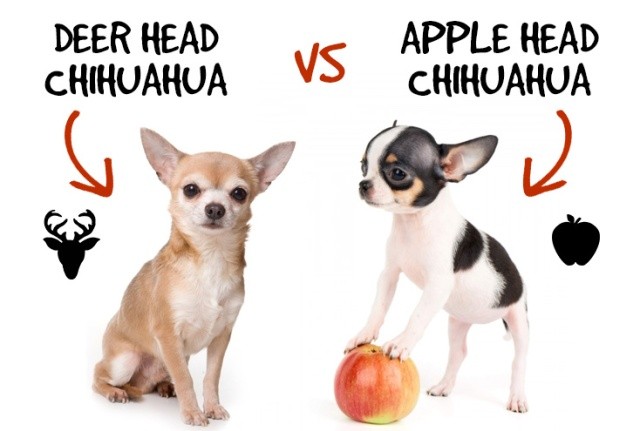
The Chihuahua, recognized as Mexico's national dog and the smallest purebred canine by the American Kennel Club (AKC), exists in two distinct head shapes - the apple head and deer head varieties. While not separate breeds, these variations exhibit notable differences in their physical structure and appearance. The apple head Chihuahua, characterized by its distinctive 90-degree angle between forehead and muzzle and dome-shaped skull, is the only variety that meets AKC show standards. Meanwhile, the deer head variety features a gentler 45-degree slope and longer muzzle. Both types share common temperamental traits including loyalty, alertness and strong personalities despite their diminutive size.
Apple Head vs Deer Head Chihuahua Physical Differences
Skull Structure and Facial Features
The key anatomical difference between apple head and deer head Chihuahuas lies in their distinctive skull shapes. Apple head Chihuahuas have a rounded "apple dome" skull with a 90-degree angle where the muzzle meets the forehead, creating an L-shaped profile. In contrast, deer head Chihuahuas have a more gradual 45-degree slope between the forehead and muzzle, resembling a young deer's facial profile.
Molera and Birth Characteristics
A unique trait of apple head Chihuahuas is that they are born with a molera (soft spot) on their skull, similar to human babies. This natural opening helps with birthing due to their larger head size but typically closes within 3-4 months. Deer head Chihuahuas rarely have a molera present at birth since their skulls are narrower, making the birthing process easier for the mother dog.
The Distinctive Head Shape and Physical Features of Apple Head Chihuahuas
Head Size and Proportions
Apple head Chihuahuas have distinctively large heads in proportion to their body size. Their skull dome is wider than their muzzle, giving them their characteristic apple-like appearance. The head typically measures around 4-5 inches in width for adult dogs. The breed standard requires a well-rounded "apple dome" skull shape.
Eye and Ear Features
The breed displays prominent, round eyes that are set wide apart on their domed head. According to the AKC breed standard, the eyes should be luminous and expressive, while the ears must be erect and positioned at a 45-degree angle when alert. The large eyes and erect triangular ears contribute to their alert, expressive facial appearance that is a hallmark of the breed.
Note: While previous sections covered skull structure and molera characteristics, this report focuses specifically on head proportions and facial feature details not previously discussed.
Apple Head vs Deer Head Chihuahua: Key Differences
Size and Weight Variations
Apple head Chihuahuas are generally smaller, weighing 4-6 pounds, while deer head Chihuahuas tend to be larger at 6-8 pounds due to their taller frame and longer legs. The apple head variety typically stands 6-9 inches tall, whereas deer heads can reach heights of 8-12 inches at the shoulder.
Neck and Body Structure
While previous sections focused on head characteristics, there are key differences in overall body structure. Apple head Chihuahuas have shorter necks and more compact bodies compared to deer heads. Their shorter jawline and neck create a more cobby appearance. Deer head Chihuahuas display longer necks, more elongated muzzles, and a generally more proportional body structure with longer legs, giving them a more balanced look overall.
Apple Head vs Deer Head Chihuahua Show Standards and Recognition
Breed Standard Requirements
While both varieties are part of the same breed, only apple head Chihuahuas can participate in show rings according to the American Kennel Club (AKC) breed standard. This is specifically due to the requirement for a well-rounded "apple dome" skull shape. The breed standard focuses on the distinctive 90-degree angle stop and rounded head rather than the sloped profile seen in deer heads.
Historical Recognition Changes
According to breed history, when the Chihuahua was first recognized by the AKC in 1908, the distinction between head shapes was not part of the official standard. The emphasis on the apple dome head shape emerged later as the breed standard evolved. Today, while both varieties are considered purebred Chihuahuas, only the apple head conformation is eligible for championship show competition, though deer heads can still participate in other dog sports and activities.
Conclusion
The research clearly demonstrates distinct differences between apple head and deer head Chihuahuas, primarily in their skull structure and physical characteristics. Apple head Chihuahuas feature a rounded dome skull with a 90-degree angle where the muzzle meets the forehead, while deer heads have a more gradual 45-degree slope. Apple heads are generally smaller (4-6 pounds) with shorter necks and more compact bodies, whereas deer heads are larger (6-8 pounds) with longer necks and more proportional bodies. A unique trait of apple heads is the presence of a molera (soft spot) at birth, which is rarely found in deer heads.
These differences have important implications for breed recognition and showing, as only apple head Chihuahuas meet AKC breed standards for show competition. While both varieties are considered purebred Chihuahuas, the emphasis on the apple dome head shape in breed standards has created a clear distinction in how these dogs can participate in formal dog events. This understanding is crucial for breeders, show participants, and potential Chihuahua owners in making informed decisions about which variety best suits their needs and interests.